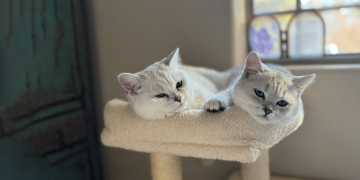Bringing different animals together under one roof is a dream for many pet lovers. The wagging tail of a Labrador, the quiet presence of a lounging tabby, the twitch of a rabbit’s nose—they each add warmth and personality to a home. But come mealtime, that harmonious picture can dissolve into chaos. Dogs bolt toward everyone’s bowls, cats swipe at their neighbor’s portion, and rabbits sit confused or anxious amid the bustle. Feeding a multi-species household isn’t as simple as dropping food into different dishes. It’s a nuanced dance involving routine, spatial awareness, timing, and behavioral insight. In 2025, as more households bring home both cats and dogs—and increasingly, small mammals like rabbits or guinea pigs—the question becomes: how can you feed everyone safely and calmly without turning into a full-time zookeeper? The answer lies in smart strategies that balance species-specific needs with household harmony.
Understanding the Unique Feeding Needs of Each Species
Before diving into logistics, it’s important to understand that dogs, cats, and rabbits aren’t just different in appearance and personality—they have fundamentally different digestive systems and feeding behaviors.
Dogs are opportunistic omnivores. They’ll eat almost anything they perceive as edible, whether or not it’s good for them. Many dogs are fast eaters, prone to gulping their food or stealing from other pets. They also respond to visual cues, so if they see food being served—anywhere—they’ll assume it’s for them.
Cats, on the other hand, are obligate carnivores. Their natural feeding pattern involves small, frequent meals throughout the day. Many cats are picky eaters and don’t like to be watched while eating. Some will refuse to eat near other animals, while others will guard their dish long after they’re done eating.
Rabbits are strict herbivores with delicate digestive systems. They should have unlimited access to hay, with carefully controlled portions of fresh greens and pellets. Rabbits are prey animals by nature, and mealtime chaos can make them anxious enough to skip eating—an issue that can quickly turn into a medical emergency.
Recognizing these differences is the first step in designing a feeding plan that prevents food stealing, reduces anxiety, and protects your pets’ health.
Designing Feeding Zones by Height, Access, and Instinct
One of the simplest yet most effective feeding strategies in multi-species households is vertical and spatial separation. Dogs are ground feeders. Cats can and prefer to eat up high. Rabbits need a quiet, low area with minimal traffic. This natural inclination can work in your favor.
For dogs, establish a designated feeding spot—ideally in the kitchen or laundry area—that has physical boundaries. Baby gates, crates, or even a closed room during meals can help contain their enthusiasm and prevent bowl surfing.
Cats thrive when they eat on raised surfaces. Install wall-mounted feeding shelves, or place their bowls on a tall countertop or dedicated cat tree platform. This keeps their meals out of reach from dogs and provides a sense of security during feeding.
Rabbits should have a calm, low-traffic corner of their enclosure for hay racks and food dishes. Avoid placing them near a dog’s barking zone or a cat’s prowling path. Even the scent or presence of another animal nearby during meals can make a rabbit nervous.
Use carpets, mats, or placemats under bowls to reduce sound (metal bowls clanging can scare small animals) and to keep bowls from sliding during feeding.
Timing Hacks That Keep the Peace
Feeding all pets at once may seem efficient, but it can easily lead to stress, food theft, or digestion issues. Instead, stagger meal times based on behavioral needs.
Start with the species that requires the most focus or protection—in many cases, the rabbit. Offer their greens and pellets in a quiet room before other animals are released for mealtime.
Next, feed cats in their elevated spots. Because cats nibble and pause, allow them extra time to finish. You can use microchip-controlled feeders to ensure each cat only accesses their own portion.
Lastly, feed the dog in a closed room, crate, or pen, especially if they finish meals quickly. This prevents them from roaming for leftovers.
If your dog is known to hover or gets overly excited during others’ meals, give them a food puzzle, Kong toy, or slow feeder bowl to extend their eating time and keep them mentally stimulated away from the action.
Portion Control and Bowl Types Matter More Than You Think
For a peaceful feeding routine, portion control is essential. Free-feeding (leaving food out all day) can lead to overeating, especially if pets sneak each other’s food. It also increases food guarding behavior and discourages healthy hunger cues.
Use pre-measured containers or digital kitchen scales to portion meals accurately, especially for cats and rabbits. Overfeeding rabbits pellets, in particular, can lead to dental and gut issues.
Invest in species-specific bowls. Rabbits do best with low, wide ceramic dishes that can’t be tipped. Cats often prefer shallow dishes that don’t touch their whiskers. Dogs benefit from non-slip stainless steel or elevated feeders for larger breeds.

For tech-savvy households, timed feeders can automate cat or rabbit meals if you’re not home during the day. Some feeders can even differentiate between pets using microchips or collar tags—an excellent option if you have multiple cats with varying diets.
Training and Reinforcement for Mealtime Manners
Even in a mixed-species household, pets can be trained to associate mealtime with calm behavior. Start by reinforcing quiet, stationary behavior before setting down bowls. For dogs, basic “stay” or “place” commands can be practiced before meals. Reward with a calm tone—not overexcitement.
Cats can be taught to eat from designated spots with the help of clicker training or consistent food placement. Avoid switching feeding locations frequently, as cats value routine and territory.
Rabbits may not learn verbal commands, but they respond well to consistency. Use soft voice cues during feeding to reassure them, and never move their food bowls while they’re eating.
If your pets show food aggression or guarding behaviors, consult a professional animal behaviorist early. These issues can escalate, especially when different species are involved, and proactive training can prevent dangerous confrontations.
Dealing with Special Diets or Medical Feeding Needs
In any multi-pet household, at least one animal may eventually require a special diet—whether for weight management, kidney support, allergies, or post-surgery recovery. The challenge is keeping that pet on their plan without disrupting everyone else.
Use marked containers or colored bowls to distinguish diets. Store food in separate bins or sealed canisters to prevent cross-contamination. If one pet requires frequent small meals (like a diabetic cat or a rabbit in recovery), consider isolating them during feeding and using logs to track intake.
In cases where one pet is on a high-calorie recovery diet, like post-surgery dogs or aging rabbits, you may need to schedule private mealtimes in another room. This also reduces jealousy or food anxiety in other pets.
What to Watch For: Red Flags in Multi-Species Feeding
Even with the best intentions, issues can arise. Watch for signs of stress at mealtime: growling, pawing at other pets’ bowls, hiding during feeding, or rushing to vomit food. These are cues that your current system may need adjustment.
In rabbits, refusal to eat or suddenly eating much slower can indicate serious stress or illness. For cats, guarding a bowl long after finishing or avoiding their usual eating spot suggests discomfort. For dogs, pacing, whining, or gulping food without chewing could signal anxiety or overexcitement.
The solution may be as simple as spacing bowls further apart, switching feeding order, or providing visual barriers like playpens or doors between feeding areas.
Building a Routine That Everyone Understands
Animals crave predictability. Feeding routines grounded in consistency create security, and this reduces mealtime stress across the board. Try to feed your pets at roughly the same times daily and in the same locations. Add simple rituals—like a verbal cue, a short walk before dinner, or soft music—that help pets anticipate what’s coming without overstimulation.
A consistent environment gives your animals the confidence to eat well, without looking over their shoulder. For multi-species homes, this is essential—not only for peace but for the long-term physical and emotional health of your pets.
Final Thoughts: Harmony in the Bowl Means Harmony in the Home
Feeding a household of mixed pets is part science, part choreography, and part patience. It’s about honoring each species’ nature while finding rhythms that work for the collective. With the right setup, mealtime doesn’t have to be stressful. It can become a ritual—one that brings you closer to your animals and makes your home feel balanced and calm, even during those wild dinnertime moments.
Whether you’re dealing with a greedy Labrador, a high-strung tabby, or a sensitive bunny, the answer isn’t more control—it’s more understanding. And when you understand how each animal eats, thinks, and responds to their environment, feeding becomes less about conflict—and more about care.















































